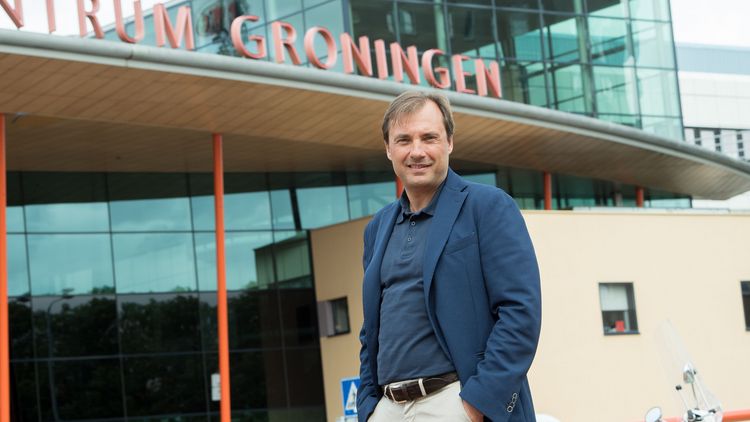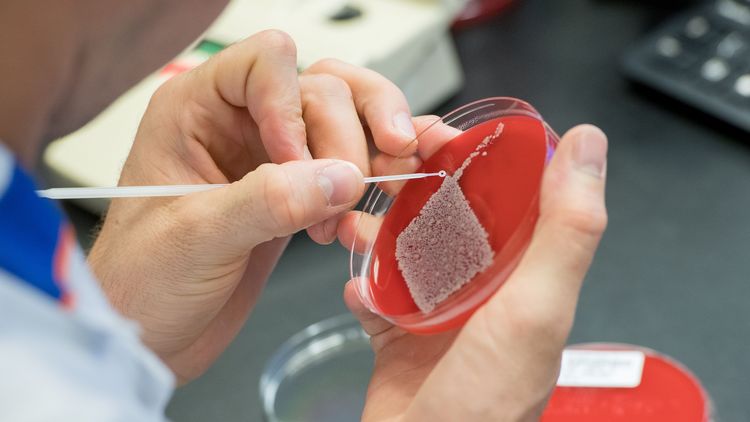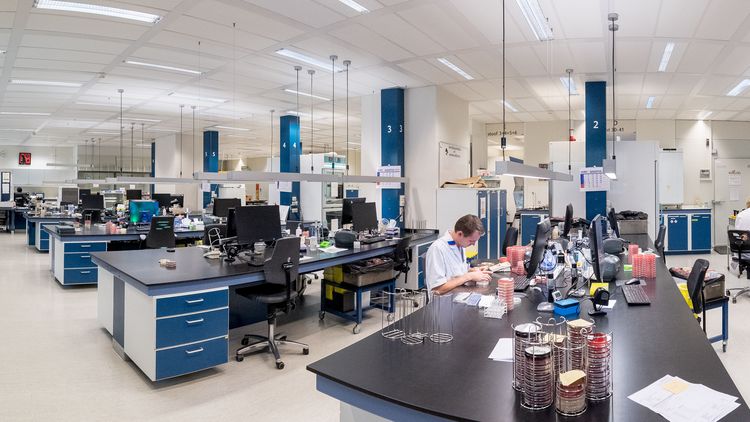What can be done to fight multidrug-resistant germs in German hospitals? A Dutch-German team led by medical microbiologist Alexander Friedrichs is looking for solutions.
In Germany, multidrug-resistant bacteria are a severe problem in hospital care. Infections with bacteria that are resistant to several antibiotics are ten times as common as in the western neighboring country, the Netherlands. The problematic bugs include, for example, multidrug-resistant staphylococci, also known as MRSA. This is a variant of a widespread species of microbes that is resistant to most antibiotics. “One might expect to see such immense microbiological variations between northern and southern Europe, but not between Germany and the Netherlands,” says Prof. Dr. Alexander Friedrich, director of the Department of Medical Microbiology and Infection Prevention at the University Medical Center Groningen.
Friedrich, who was a long-time member of the Scientific Advisory Board of the European Medical School Groningen-Oldenburg, works closely with Oldenburg’s School of Medicine in order to solve the germ problem. The researchers focus on organizational differences between Germany and the Netherlands. “The two countries differ in many respects when it comes to patient care,” says Friedrich. This is particularly true in Friedrich’s area of expertise, medical microbiology and hospital hygiene. The higher prevalence of MRSA bacteria is not so much a result of insufficient awareness about the importance of disinfection or how to use antibiotics.
Factors beyond medical knowledge
“Of course German doctors know all about hygiene or how to do a screening. This means that factors beyond medical knowledge must be in play,” Friedrich concludes. Friedrich is heading a German-Dutch EU-programme called EurHealth-1Health to focus on pinpointing those factors and bringing German hospitals in line with Dutch standards. The University of Oldenburg is also on board.
A number of organizational differences between the two countries are immediately apparent. For example, in the Netherlands almost every hospital has one or more own medical microbiologists who quickly determine the right antibiotic for patients with bacterial infections. In order to prevent the spread of germs, this doctor has the authority to initiate preventive microbiological screenings. In Germany, by contrast, such specialists are rare in acute care hospitals. Although in both countries high-risk patients – for example farmers or travellers who have been to a hospital abroad – are tested upon admission for resistant germs, in the Netherlands all patients who are admitted to a high-risk ward such as intensive care are also screened. “Particularly if a patient comes from another hospital or a nursing home that is known to have an outbreak, patients are screened, in some cases on a weekly basis,” Friedrich reports.
Enough room for isolation
Until the swabs are negative, patients in the Netherlands are kept isolated in single rooms. “This prophylactic isolation is rarely used in German hospitals,” says Friedrich. This, he explains, is because in most cases as many beds as possible need to be used primarily for economic reasons. Hence it’s not easy to keep patients isolated. The Dutch healthcare system, by contrast, is organized in such a way that on average only 60 percent of the beds need to be occupied. “This means there’s enough space for isolation care,” Friedrich says. “So whether a patient can be isolated or not seems to be influenced to a large extent by the remuneration system in a country and not so much by medical reasons.”
At the healthcare system level there are many other differences: in Germany the number of hospitals per inhabitants is three to four times higher than in the Netherlands, where at the same time there are no specialists in own practice. “To date, no one has made a careful analysis of whether and how these differences affect the use of antibiotics and the spread of resistant germs,” Friedrich says. Researchers at the Crossborder Institute for Health-Care and Prevention, a joint facility of the University of Oldenburg and the University of Groningen’s Aletta Jacobs School of Public Health, plan to carry out a structured comparison of the two healthcare systems –with the goal of identifying the best means to control the germ problem. This cross-border research has been given high priority by the government of Lower Saxony.
But simply applying the Dutch strategies to Germany wouldn’t make sense in Friedrich’s opinion. “There are too many country-specific differences which first need to be understood. Not all measures can be replicated one to one but have to be implemented in the right places of the respective system,” he explains. In a region where there is a lot of farming, livestock can be a source of resistant germs, whereas in another region the transfer of patients from a certain clinic to other hospitals might be the main route of infection.
Hubs for resistant germs
Indeed, in 2015 Friedrich and colleagues were able to demonstrate in a study that antibiotic-resistant germs often follow patient flows. If there is an outbreak in one hospital in a region the resistant germs spread rapidly through the transfer of patients to other clinics in the area. The study showed that these transfers do not occur randomly in all directions, but that individual hospitals – and in some cases even individual wards, for example the intensive care ward – become a kind of hub, distributing pathogens across the entire hospital and region. “We want to track down these hubs. If treatment with antibiotics and hospital hygiene are properly implemented at these hubs, all parties benefit – in our opinion even the facilities where things are not going well,” Friedrich stresses.
For researchers in Groningen and in Oldenburg there are numerous approaches for studying and comparing the healthcare systems and their organization in Germany and the Netherlands. The EurHealth-1Health project has already initiated changes: training programmes for hygiene specialists are to be harmonised in the long term and mutually recognised in the short term – in a subproject run jointly by the University of Oldenburg and the Oldenburg Klinikum. Together with employees of the University of Oldenburg, Alexander Friedrich will also begin to study the infection routes of multidrug-resistant bacteria in Germany in more detail. Because, as he says, one thing is clear: “These bacteria don’t just spread at random.”



